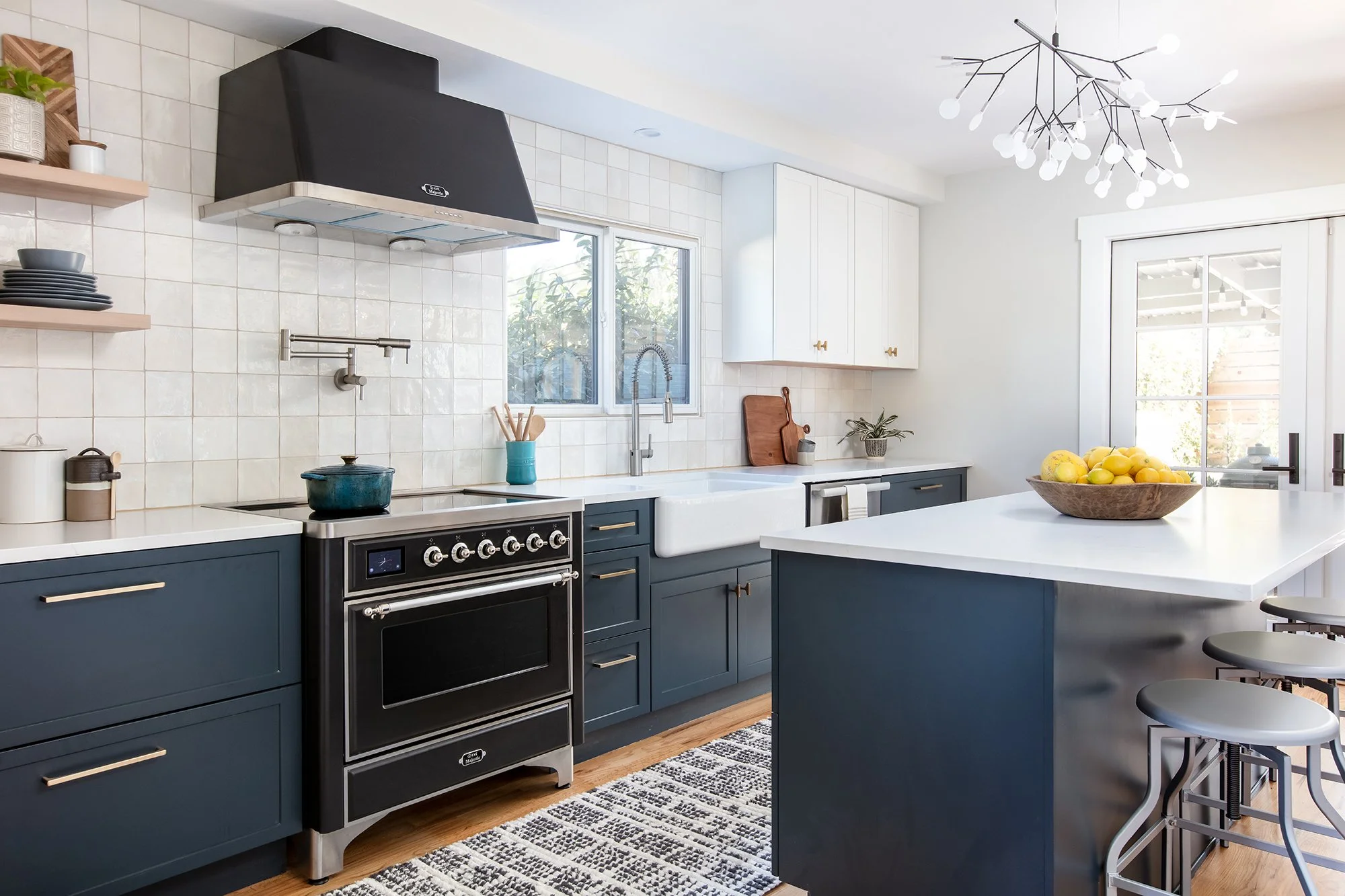What No One Tells You About Great Lighting
Want to know one of the easiest ways to spot a well-designed home? Layered lighting. Why? Because the secret to a home that looks like it belongs in a magazine is that it has a beautiful balance of great lighting. It’s about mixing ambient, task, and accent light, paired with the right scale and smart placement.
The rule of thumb is to layer at least 2 lighting sources in every room. When done thoughtfully, this layering transforms your home from flat and functional to warm, inviting, curated and elevated.
In this guide, we’ll break down lighting room by room so you can master the art of layering and achieve that designer-level glow throughout your home!
Living Room Lighting


In your living room, lighting is just as important as your furniture and finishes and the key to creating an elevated living room is layering—combining ambient, task, and accent lighting so the space feels both functional and inviting at any time of day. Often recessed lighting is a good base to start with (of course always on a dimmer). if you’re not a fan of recessed overhead lighting, then start with a strong overhead fixture. This is also a fun opportunity to showcase a statement piece if that’s your vibe.
Then, you layer!
Living room light layering tips:
Lamps
A must for creating a cozy, layered glow.
Mix table lamps and floor lamps for depth and warmth.
Overhead Lighting
Anchor the space with a chandelier, pendant, or flush mount.
Use the size rule: add the room’s length + width in feet, then convert to inches for the ideal fixture diameter. (e.g., 10’ x 15’ room = 25” wide fixture).
Sconces & Wall Lighting
Perfect for adding ambiance without taking up floor space.
Try flanking a fireplace, framing built-ins, or brightening dark corners.
Picture lights and uplighting highlight artwork and architectural details.
Accent Lighting
Layer in unexpected touches like LED strips under shelving, backlit panels, or directional spotlights.
Adds visual interest and dimension, especially in the evenings.
Kitchen Lighting




Lighting has the power to transform a kitchen from purely functional to warm, stylish, and layered. Recessed lights create a sleek foundation, while pendants, sconces, and chandeliers add depth, personality, and task lighting where you need it most. A thoughtful mix not only brightens your kitchen but also ties together finishes, highlights architectural details, and creates a space that feels as good as it looks! There’ SO much to say about kitchen lighting so enjoy the quick tips below and for more, visit our Lighting: Kitchen Remodel Series Part 5 blog post.
Kitchen lighting ideas:
Recessed Lighting
Space cans about 4 feet apart for even coverage.
Choose 2,700K–3,000K bulbs for a warm, inviting glow.
Pendants
Ideal for islands and sinks.
Hang pendants 28”–36” above the counter.
Space 24”–30” apart over large islands.
Sconces
Add charm, warmth, and mood lighting.
Great placement ideas: over the sink, flanking the range, highlighting artwork, accent walls, or floating shelves.
Chandeliers
No longer limited to grand entryways—this can be a great option for over a large island.
Perfect for making a statement while adding drama and elegance to the kitchen.
Dining Room Lighting



The dining room is where lighting sets the tone—whether it’s an intimate dinner, a lively family gathering, or holiday entertaining. The right mix of fixtures provides both function and atmosphere, with chandeliers and pendants taking center stage, sconces adding mood, and recessed lighting offering subtle balance. A well-designed plan creates a warm, inviting environment that feels layered and intentional.
Chandeliers
The most classic choice for dining rooms—always a statement piece.
Hang 30”–36” above the table surface (measured from the tabletop).
Choose a fixture about ½ to ⅔ the width of your dining table for ideal scale.
Pendants
Use a single bold pendant for round tables.
Hang at the same height guideline as chandeliers: 30”–36” above the table.
Sconces
Add soft, ambient light and visual depth to the room.
Place them on side walls to frame a buffet, console, or artwork.
Dimmer switches are a must for creating mood.
Lamps
If you have a buffet or console, consider a table lamp for a charming glow.
Recessed Lighting
Best used sparingly in dining rooms—think background support, not the star.
Place around the perimeter of the room to wash walls with light rather than directly overhead.
Bedroom Lighting



Bedroom lighting should feel equal parts functional and relaxing—a balance between task lighting for reading, soft ambient lighting for winding down, and accent lighting to add character. A thoughtful layered approach ensures the room adapts to every mood and moment, from early morning routines to cozy nights in.
Ceiling Fixtures
Scale matters: larger rooms can handle statement fixtures, while small rooms benefit from low-profile flush or semi-flush mounts.
Ceiling fans have come a long way so if you need a breeze at night, just make sure you choose a more modern, elevated style.
Recessed Lighting
Works best as supportive, ambient light.
Place around the room perimeter rather than directly overhead of the bed.
Use dimmable, warm bulbs (2,700K–3,000K) to create a restful glow.
Bedside Lighting
Lamps, sconces, or pendants are perfect for nighttime reading and task lighting.
Swing-arm sconces or hanging pendants free up surface space on nightstands.
Position sconces or pendants about 18”–24” above the nightstand for easy reach.
Bathroom Lighting




Bathroom lighting needs to be both hardworking and beautiful. It should provide bright, accurate illumination for daily self-care routines while also offering softer layers that make the space feel calm and spa-like. By combining ceiling, vanity, and accent lighting, you can achieve a bathroom that’s as functional as it is inviting.
Ceiling Fixtures
Recessed lights are ideal for overall illumination—space them evenly across the ceiling.
A flush or semi-flush mount works well in smaller baths as a stylish focal point.
In larger baths, a chandelier or pendant above the tub adds drama (always check code clearances).
Vanity Lighting
The most important layer for tasks like shaving and makeup.
Opt for sconces, vertical fixtures at eye level (65”–70” from the floor) or horizontal fixture 2/3rd the length if the vanity mirror.
Aim for 3,000K–3,500K bulbs for a natural daylight effect.
Shower & Tub Lighting
Use wet-rated recessed lights directly over the shower or tub for safety.
For freestanding tubs, a pendant or chandelier creates a stunning focal point while elevating the space.
Accent Lighting
Toe-kick lighting is perfect for night use without turning on bright overheads.
Thanks for reading!
Lighting may seem like a small detail, but it’s the detail that makes all the difference. When you layer your light thoughtfully, every corner of your home feels intentional—like it was designed with both comfort and beauty in mind. So whether you’re refreshing one room or rethinking your whole house, let lighting lead the way to a space that truly shines.
This post contains affiliate links. If you purchase something we may earn a commission.































